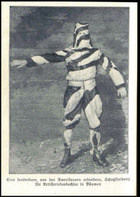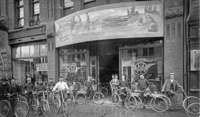Militarized Visualities and Urban History
We kindly invite you to the guest talks Noemi Quagliati and Talitta Reitz (AI/LMU University) on Thu, 22.06.2023, 2-4pm, in S007 (Schellingstr.3)
20.06.2023
Militarized Visualities: Photographed and Camouflaged Landscape in WWI
Talk held by Noemi Quagliati (Amerika-Institut/LMU München)
 Focusing on the establishment of photoreconnaissance during the First World War, this talk shows how specific photo-optical artifacts (aerial cameras), photographic techniques (stereoscopy and photomosaic mapping), and visual deception (camouflage) challenged military activity while remodeling civilians’ perception and conception of the landscape. In particular, the presentation explores the familiarization of the American public with camouflage. It outlines the evolution of military camouflage from the animal world and the employment of visual art techniques for disguising battlefields. The opposing propaganda strategies used by the Allies and the Central Powers to communicate concealment and deception are highlighted.
Focusing on the establishment of photoreconnaissance during the First World War, this talk shows how specific photo-optical artifacts (aerial cameras), photographic techniques (stereoscopy and photomosaic mapping), and visual deception (camouflage) challenged military activity while remodeling civilians’ perception and conception of the landscape. In particular, the presentation explores the familiarization of the American public with camouflage. It outlines the evolution of military camouflage from the animal world and the employment of visual art techniques for disguising battlefields. The opposing propaganda strategies used by the Allies and the Central Powers to communicate concealment and deception are highlighted.
image source: “Flugzeug-Spione” Berliner Illustrirte Zeitung no. 15 (14 April 1916), 116.
Cycling before Green: An Urban History of Portland and Munich
Talk held by Talitta Reitz (Amerika-Institut/LMU München)
 Today most city planning discourses encourage cycling as a "sustainable" practice. But cycling started as a means to speed, modernity, and autonomy. Despite the rise of automobile markets and auto-centric city planning, cycling never truly vanished in some European cities like Munich. In the United States, the story was different. Portland, Oregon, is now one of the top cycling cities in the country, and yet for many decades, cycling was practically dead until its 1970s comeback (a similar pattern to other North-American cities). So, why did European countries and the United States follow somewhat different "bicycle paths"? How did cycling emerge in Portland and what led to its long-lasting decay and late revival? How different was the practice of cycling before it became "good for the environment"?
Today most city planning discourses encourage cycling as a "sustainable" practice. But cycling started as a means to speed, modernity, and autonomy. Despite the rise of automobile markets and auto-centric city planning, cycling never truly vanished in some European cities like Munich. In the United States, the story was different. Portland, Oregon, is now one of the top cycling cities in the country, and yet for many decades, cycling was practically dead until its 1970s comeback (a similar pattern to other North-American cities). So, why did European countries and the United States follow somewhat different "bicycle paths"? How did cycling emerge in Portland and what led to its long-lasting decay and late revival? How different was the practice of cycling before it became "good for the environment"?
image source: Oregon Historical Society
These guest talks held by Noemi Quagliati and Talitta Reitz are part of the lecture series "Crises-Wars-Environments" (convener: Prof. Dr. Christof Mauch).



